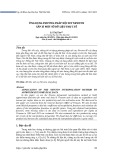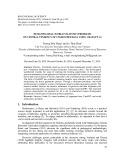
T
ẠP CHÍ KHOA HỌC
TRƯ
ỜNG ĐẠI HỌC SƯ PHẠM TP HỒ CHÍ MINH
Tập 22, Số 3 (2025): 424-436
HO CHI MINH CITY UNIVERSITY OF EDUCATION
JOURNAL OF SCIENCE
Vol. 22, No. 3 (2025): 424-436
ISSN:
2734-9918
Websit
e: https://journal.hcmue.edu.vn https://doi.org/10.54607/hcmue.js.22.3.3999(2025)
424
Research Article1
A GENERALIZED DISTRIBUTIONAL INEQUALITY AND APPLICATIONS
Le Khanh Huy
Ho Chi Minh City University of Education, Vietnam
Corresponding author: Le Khanh Huy – Email: huytpthcs@gmail.com
Received: October 13, 2023; Revised: March 30, 2024; Accepted: June 05, 2024
ABSTRACT
The distributional inequality recently introduced by Tran and Nguyen has been used to
investigate gradient estimates for solutions to partial differential equations. In particular, the
authors established several sufficient conditions under which two measurable functions can be
compared via their norms in general Lebesgue spaces. The results are then applied to some classes
of p-Laplace type problems. This paper extends this inequality to make it applicable to a broader
range of equations. Specifically, we propose a generalized distributional inequality that can be
applied to the p(x)-Laplace equation, the typical version of quasi-linear elliptic equations with
variable exponents.
Keywords: Generalized distributional inequality; Lorentz spaces; p(x)-Laplace equation;
Quasi-linear elliptic problems; Regularity theory; Variable exponents
1. Motivation and introduction
Let
Ω
be an open bounded domain in
n
and
,
be two Lebesgue measurable
functions defined in
Ω
. In recent papers, Nguyen et al. (2021) and Nguyen and Tran (2021)
proved the following distribution inequality.
,
ab
d Cd d
α αα
ε λ ε λ ελ
(1.1)
for all
0
λ
and
0
ε
small enough, under some sufficient conditions of
and
. Here,
a
and
b
are two positive constants, and the distribution function
h
d
α
is considered as the
Lebesgue measure of level sets corresponding to the fractional maximal operators
α
Μ
.
More precisely,
h
d
α
is defined by
: : for 0,
h
d x hx
αα
λ λλ
Ω
Μ
where
h
is
measurable in
Ω
and
α
Μ
is the fractional maximal operator (see Definition 2.2). The most
interesting point is that the distribution inequality (1.1) implies the following statement
,
αα
ΜΜ
(1.2)
Cite this article as: Le, K. H. (2025). A generalized distributional inequality and applications. Ho Chi Minh City
University of Education Journal of Science, 22(3), 424-436. https://doi.org/10.54607/hcmue.js.22.3.3999(2025)

HCMUE Journal of Science
Vol. 22, No. (2025): 424-436
425
in several function spaces
and
, such as Lebesgue space, Lorentz space, or Orlicz space.
The statement in (1.2) has many meanings about the fractional maximal operator, which is
closely related to the fractional order derivative and Riesz potential (Muckenhoupt &
Wheeden, 1974). On the other hand, using the boundedness property of maximal operators
Μ
, one can obtain that
.
If we present
and
as the terms of data and solutions of partial differential
equations, respectively, then we can obtain a regularity result for solutions. This type of
result has been studied in many works (Acerbi & Mingione, 2005, 2007; Byun & Ok, 2016).
By (1.2), Nguyen and Tran (2021) presented some applications to obtain the regularity
results for some classes of quasi-linear elliptic equations, such as the p-Laplace equation and
the obstacle problems associated with the p-Laplace operator. The method can be applied to
many other problems (Nguyen et al., 2023; Tran & Nguyen, 2022a, 2022b, 2023; Tran et al.,
2023). However, it cannot be applied to several cases of problems, such as the quasi-linear
elliptic systems, the non-linear problems with variable exponents, and the measure data
problems. Motivated by these works, this study aims to establish a new distribution inequality
that is more general than (1.1) for applying to larger classes of partial differential equations.
We now introduce some general notations. We write
r
Bx
to indicate the ball with
radius
0r
and centered at
n
x∈
and
ΩΩ
rr
x Bx
. Next, notation
B
presents the
Lebesgue measure of the measurable subset
n
B
. For simplicity of notation, the set
h
λ
will be used instead of
Ω:x hx
λ
. On the other hand, we always consider
the letter
C
as a general constant, and its value may change from different lines of estimates.
Let us consider two given vector-valued functions
u
and
:Ω
m
v
with
1m≥
. Assume
that
f
,
: 0,
m
g
and
:Ω 0,F
satisfy all the following assumptions. We will
write
fu
instead of
fuz
with
Ωz
.
Assumption 1.1. There exists a constant
0C
not depending on
u
and
v
such that
and , in Ω.fu Cfu v fv fv Cfu v fu
Assumption 1.2. There exists a constant
0C>
not depending on
f
,
g
and
F
such that
d d.fu z C gu Fz z
ΩΩ
Assumption 1.3. There exists a constant
00R
and
Θ1
satisfying
0 20
1
Θ
Θ
ΩΩ
0 20
1d 1d
ΩΩ
rr
xx
rr
C
fv z fv z
xx
for all
0
xΩ
and
0
0;
rR
.
Assumption 1.4. There exists a constant
0
κ
and
0C
such that the following inequality
0 00 0
1 2 12
Ω ΩΩ Ω
ddd d
r rr r
x xx x
fu v z fu z gu z C Fz z
κ
τ τ ττ
,

HCMUE Journal of Science
Le Khanh Huy
426
holds for every
1
τ
,
20,1
τ
,
0r
and
0
xΩ
. Let us now state our main results under
Assumptions 1.1–1.4. The results are studied in two steps. In the first step, we construct the
following distribution function inequality
,
a bc
F
fu fu gu
d Cd d d
α αα α
ε λ ε λ ελ ελ
for
ε
small enough and
λ
large enough. Using this inequality and the definition of norm in
Lorentz space
,Ω
qs
L
, we can show that
, ,,
Ω ΩΩ
1
qs qs qs
L LL
PC F Q
α αα
Μ ΜΜ
for a suitable value of
α
, where
P fu
and
Q gu
.
In the next section, we recall some well-known definitions of Lorentz spaces and
fractional maximal operators, and we present key results concerning the boundedness of the
maximal operator. In Section 3, we establish the general form of the level set inequality,
from which the distributional inequality is derived. Then we also obtain the norm estimates
in Lorentz space. These proofs are presented in Section 4. In the last section, we discuss
some applications to quasi-linear elliptic problems involving variable exponents.
2. Lorentz spaces and maximal operators
In this section, let us recall the definitions of Lorentz spaces, fractional maximal
operators, and distribution functions associated with maximal operators. Moreover, we
present some useful boundedness properties of maximal operators.
Definition 2.1. (Lorentz spaces) For some
0,
q
and
0,s
, the Lorentz space
,Ω
qs
L
is defined as the set of all Lebesgue measurable functions
h
on
Ω
such that
,
1
Ω0
d
:Ω: ,
qs
ss
sq
L
h q x hx
λ
λλ
λ
(2.1)
as
s
and
,
1
0
: sup : .
q
q
L
h x hx
λ
λλ
Ω
Ω
Definition 2.2. For every
0,n
α
, the fractional maximal operator
α
M
is defined by
1
loc
0
( ).
sup d , for ,
r
nn
Bx
rr
r
hx hy y x h L
Bx
α
α
M
If
0
α
, it coincides with the Hardy-Littlewood operator, i.e.
0
ΜΜ
. The two following
results (Propositions 2.3 and 2.4) can be found in Grafakos (2004).
Proposition 2.3. The Hardy-Littlewood operator
Μ
is bounded from
qn
L
to
,qn
L
for all
1q
. This means there exists a constant
0C
such that
: d , forall 0 and .()
n
q
n qn
q
C
x hx hx x h L
λλ
λ

HCMUE Journal of Science
Vol. 22, No. (2025): 424-436
427
Proposition 2.4. Operator
Μ
is bounded in Lorentz space
,
qs n
L
for all
1q
and
0s
. This means there exists a constant
0
C
such that
,,
,
qs n qs n
LL
h Ch
Μ
for all
,qs n
hL
.
Let us now state the boundedness properties of fractional maximal operators (see Tran &
Nguyen, 2020 for the proofs).
Proposition 2.5. (Tran & Nguyen, 2020) For all
0,n
α
, there holds
1
: d,
n
n
n
n
x hx C hy y
α
α
λλ
Μ
for all
0
λ
and
1n
hL
.
Corollary 2.6. Let
0n
α
,
0r
and
n
x
. Then exists a constant
0
C
satisfying
,
1d
rr
n
n
Bx Bx
h C hy y
α
α
χλλ
Μ
for all
0
λ
and
1
loc n
hL
.
Proposition 2.7. (Tran & Nguyen, 2020) Assume
1
s
and
0, n
s
α
. Then exists a positive
constant
,, 0C Cns
α
such that
1d,
n
n
ns
s
s
h C hy y
α
α
λλ
Μ
for all
0
λ
and
sn
hL
.
Definition 2.8. Let
0,n
α
and
h
be a measurable function in
Ω
. We define by
h
d
α
the
distribution function of
h
as
:Ω : , 0.
h
d x hx
α
α
λ λλ
Μ
3. Main results
3.1. Generalized level-set inequality
We first prove a generalized level-set inequality, which can be obtained by the
following covering lemma.
Lemma 3.1. (Covering & Peral, 1998) Let
00R
and
be two measurable subsets
of
Ω
. Assume that
0,1
ε
satisfying
00
R
B
ε
. Moreover,
Ωx
and
0
0,rR
,
rr r
Bx Bx Bx
ε
Ω
. Then, there exists a constant
0C Cn
such that
C
ε
.
From now on, for simplicity of notation, let us denote
and .
P fu Q gu
Theorem 3.2. We assume that all Assumptions 1.1–1.4 are satisfied. For every
0, Θ
n
α
and
Θ
Θ
n
an
α
, there exist positive constants
0
λ
,
0
ε
,
b
,
c
and
0
0, ,,
D
C Cn sR
α
=
>

HCMUE Journal of Science
Le Khanh Huy
428
such that the distribution inequality
,C
ελ λ
ε
holds for all
0
0,
εε
and
0
λλ
>
.
Here
,
ελ
,
λ
are defined by
,;; .
abc
P F Q and P
ελ α α α λ α
ε λ ελ ελ λ
Μ ΜΜ Μ
Proof. The proof will be divided into two steps. In the first step, let us prove that for all
0
ε
small enough and
0
λλ
>
, there holds
0
,
0.
R
B
ελ
ε
(3.1)
We assume
,
ελ
, since (3.1) is valid if
,
ελ
. Then there exists
1Ωx
such that
1
1
11
11
0: d ,
0: d .
bb
Bx
c
Bx
c
Fx Fx x
Bx
Qx Qx x
Bx
η
η
α
α
η
α
α
η
η
ελ η ελ
η
ελ η ελ
Μ
Μ
(3.2)
Let us set
2diam ΩD
and
1
BD
Bx
, where
diam Ω
denotes the diameter of
Ω
. By
Proposition 2.7 for
1s
, we can see that
,
d.
n
n
aa
C
P Px x
α
ελ α
ελ ελ
Ω
Μ
(3.3)
Using Assumption 1.2, we observe that
d d.Px x C Qx Fx x
ΩΩ
(3.4)
Substituting (3.4) into (3.3), we can rewrite (3.3) as
,BB
d .dd
nn
nn
aa
CC
Qx Fx x Qx x Fx x
αα
ελ
ελ ελ
Ω
(3.5)
From (3.2), and choosing
2diam ΩD
η
, we have
BB
d , and d .
BB
bc
DD
Fxx Qxx
αα
ελ ελ
It follows that
BB
d , and d .
nb nc
Fx x CnD Qx x CnD
αα
ελ ελ
(3.6)
Replacing (3.5) by (3.6), we obtain
0
11
,0
0.
nn
a bn a cn
n
n bc nn R
a
CD
CnD C B
R
α
ααα
ελ
ε ελ ε ε ε
ελ
Let us choose positive constants
b
,
c
and
1
ε
satisfying conditions


























